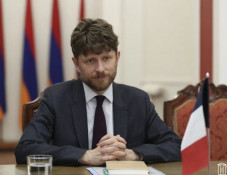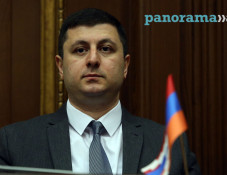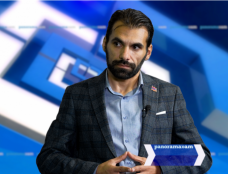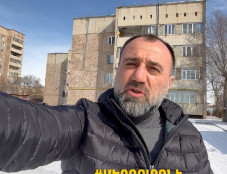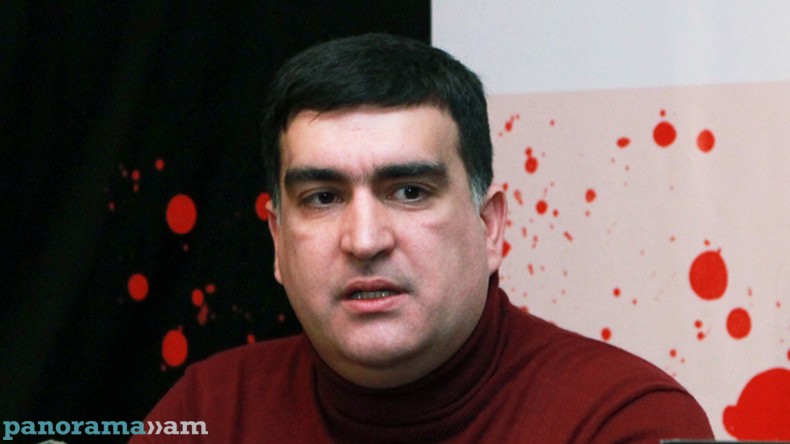
Aris Ghazinyan: Ottoman Sultan planned to pull down Etchmiadzin Cathedral to put end to everything Armenian
At the beginning of the 18th century, the global and regional political processes started to set the stage for ridding the Christion population of the Muslim pressure. The Armenian meliks’ plan to do that required a meeting with the powerful Russian monarch, during which the latter was to be convinced that the conquest of strong positions in the Transcaucasia met the interests of the empire. Armenian journalist and researcher Aris Ghazinyan writes about it in his book “Yerevan: with a cross or on the cross,” which is an attempt of setting and considering an extremely diverse range of processes directly or indirectly forming the character of the development of the territory in question and predetermining the inevitability of turning Yerevan into the main centre of the Eastern Armenia, and later on into the capital of the recovered Armenian state.
In 1701, Israel Ori set on his way to meet Peter Alekseevich in Smolensk. He presented the thoroughly elaborated plan over the necessity to send an army of twenty-five thousand (15 thousand cavalrymen and 10 thousand infantrymen) to Transcaucasia. The army would be met by the Armenian and Georgian home guard. The cavalry was to move along the Dariali Gorge, and the infantry through Astrakhan across the Caspian Sea. Peter I accepted the plan highly positively and even granted Ori the rank of colonel of the Russian Army, according to Ghazinyan.
He delegated Ori to Isfahan with a special charter to the Persian Shah. In 1709, the diplomatic mission arrived in the Persian capital following several meetings in the Transcaucasia. “It is hard to say which would be the scenario of the subsequent events if Ori did not die suddenly in Astrakhan in 1711,” Ghazinyan writes. Nevertheless, Peter I’s intention to turn his look to the south was firm and irreversible.
In summer 1722, the Russian flotilla set on the Caspian Sea towards Derbent and Baku and took Derbent in August. Tahmasp II, who had to somehow strengthen his positions in the Caucasus, granted almost limitless powers to Constantine II, the King of Kakheti, who was an apostate known as Mahmad (Muhammed) Quli Khan. An ardent Shia, he became the governor of Georgia and the ruler of Yerevan.
In 1723, Peter I commenced his second campaign. In July, the Russian troops approached Baku and took it at the end of the month. The advance of the Russian army in the Transcaucasia was agreed with the joint Armenian-Georgian forces under Vakhtang VI’s command. Among the battles unfolded in 1720, the liberation movement in the mountainous region Syunik in the south of the Eastern Armenia led by colonel David Bek, an Armenian military commander and political figure called from Georgia, was especially significant. A practically independent Armenian principality was formed here following several magnificent victories. Another huge centre of the Armenian national liberation movement was Artsakh. The war in Artsakh started in 1721 led by Avan Yuzbashi (Hovhannes Babanov). From 1724, his troops were fighting against the Persian and Ottoman armies simultaneously. Later, in 1729, he held talks with Russia for receiving military aid. Aghazar di Khachik (Lazar Khristoforov) was another prominent figure in the Armenian liberation movement in Artsakh. In 1721, he became the permanent commander of the Armenian squadron. Later, he received the rank of major general of the Russian Army.
The Ottoman army, led by Sultan Ahmed III, managed to stop the advance of the Russian army and rushed into the region in summer 1723. In spring 1724, the Ottoman army entered Eastern Armenia. Sardar Ibrahim shared with Sultan Ahmed his assumption that Afghans could attack Yerevan, and the Padishah immediately appointed Abdulla Pasha as sardar and sent him to Yerevan with 75 thousand troops. The governor of Yerevan was Mihrali Khan during the siege in 1724. The Ottoman army set a camp at the approaches of Yerevan (district Yeghvard) and sent diversionary groups of up to 1800 soldiers directly into Yerevan district from there. During one of the sorties, Mihrali Khan himself faced the diversionary soldiers. However, the Persian units were defeated in a close combat, and the khan fled to Yerevan. The Ottoman army moved its positions into the region of Karbi, a village near Yerevan.
The influential people in Karbi took counsel together and made a decision to send a person to inform the khan that the Ottomans surrounded Karbi. They started to convince him to send troops to defend the town and promised to sacrifice their own life for the defence of the town and the defeat of the enemy. The khan of Yerevan, however, did not have enough forces for his own defence and did not heed their appeals. Then, the residents of Karbi pretended to be preparing for a fight against the Ottomans. They started strengthening the residential buildings, blocked all the entrances to the town and stayed in combat readiness for many days until Abdulla Pasha arrived, according to an anonymous Armenian chronicler.
The residents of the village did this in the hope that the Yerevan khan would send troops for their defence in the end. Mihrali reacted to this promising to send them gunpowder and ammunition just to have them holding on the defence. He also said Catholicos Asdvadzadur I Hamadanetsi had gone to negotiate with Shahanshah Tahmasp II to reach an agreement over sending additional military contingent to the Ararat Plain.
However, Catholicos Asdvadzadur, who was really meeting the shah, advised to be patient. The khan’s advice really caused a destruction. That is why the influential people of Karbi decided to surrender. In order to soften the pasha’s heart, they sent him gifts. Abdulla promised not to touch their families or destroy Karbi if they voluntarily handed their arms. The precondition was accepted, and the Ottoman sardar prepared to assault Yerevan Fortress from new positions, Ghazinyan writes.
Moving closer to Yerevan, the Ottomans started shelling the fortress from cannons. Mihrali ordered the Armenians to fight with the Persians. They fought against the Ottomans for two months killing a great number of Ottoman troops without giving them the chance to go into the city. At seeing that the troops’ number was reducing, Abdulla asked for the Kurds’ help. Although the latter sent 35 thousand soldiers, they could do nothing against the defenders of the fortress. The residents’ persistent resistance and the deteriorating situation of the army forced Abdulla Pasha to retreat and turn to the sultan for help, according to the anonymous chronicler cited by Ghazinyan.
After additional troops joined, the Ottoman army again went up to Yerevan, but the defenders again did not allow them to move. All the fighters were Armenian as the Persians hid in the citadel with the Khan and left the Armenians to fight in the defenceless part of the city. According to Ghazinyan, the heroic defence of Yerevan in 1724 is one of the most glorious pages in the history of the ancient city demonstrating the “Yerevan resident of the new type,” who was capable of loving his city and sacrificing his own life for it.
The self-defence was led by Hovhannes Khindibegyan, Poghos Kichibegyan, David Mirzajanyan and Hovhannes Karchik. In Kond district, regiments of Yerevan’s gypsy Boshas, who had adopted Christianity, joined the Armenian volunteer corps. Their leaders were Ghazaros Baturyan, Kylduz, David, Bayram and Petros. The Ottoman onrush was also successfully repelled in the block Khnkanots-Dzoragyugh in the district lying on the left bank of the river Zangu. Here, the defence was organised by groups led by Avetis Sirarpionyan, Pirigul, Tadeos, Mghun, Mkrtich, Malkus, Nikalayos, Aleksan, Zohrab, Agham, Galust, Aram.
Separate groups were set for defending the passages and streets in various blocks of the city. For two months, the Ottoman troops practically failed to move to new positions and appeared unable to break the Armenian defence maintained by 10 thousand volunteers. Villagers from the neighbouring villages on the right bank of the Zangu, namely, Parakar, Gugumbet, Kavakert (Karmir Blur), Noragyugh (Yenikey), and from the eastern suburbs of Yerevan, namely, Avan, Arinj, Dzagavan, Dzag, rose to help the residents of Yerevan. Another 400 people led by the priest Movses joined the groups on the first defence border (Dzoragyugh), where the number of the fighters armed with swords and guns reached 9,500. Only the feeble old men, women and children were staying at home. All the teenagers are said to have been fighting with their fathers and elder brothers, Ghazinyan writes.
After seventy days of fighting, Abdulla requested additional troops from the sultan. An Egyptian legion of 3,000 soldiers was deployed to Yerevan. Without even receiving Abdulla Pasha’s order, these soldiers rushed into the city from Dzoragyugh, and the other troops followed them in an enormous crowd. When they got into Dzoragyugh, the defenders appeared helpless and ran to Agoriyats, the block of millers. Learning about this, the gypsies sent 300 men to help them. Firing from a higher position, they were able to kill up to 6,000 foes and force the rest to flee. The Christians lost 1,300 soldiers in that fight.
Then Sultan Ahmed III ordered to deploy two more armies to Yerevan. Meanwhile, Abdulla was so outraged that he did not even wait for the help to arrive and sent his troops to a second assault on Kond block. He failed again as the Armenians immediately moved there and bravely forced the enemy to flee.
The situation changed only after an Ottoman army of 40 thousand arrived in Yerevan. The Ottomans assaulted the city from all the sides at the same time and soon broke in. The battle between the Armenians and Ottomans continued until the evening. After fighting for three months, Yerevan was taken by the Ottoman troops on 7 June 1724. Only the well-known fortress was remaining in the city. Its soon capitulation did not raise doubts; the garrison, however, continued the defence.
The khan of Yerevan had to summon a council, which made a decision to wait for the Catholicos who was at that time on his way back from yet another meeting with the shah and could have an access to the fortress as a possible mediator, Ghazinyan writes.
From the very beginning, Catholicos Asdvadzadur I supported David Bek’s liberation war and called on the Armenians of Shamakhi, Sheki and Shirvan to support their brothers. Besides, he did not conceal his pro-Russian orientation, which raised the Muslim clergy’s reproach. The Armenian pastor told those in siege that all their expectations were in vain and called on them to lay down arms, especially given that most of the volunteers had been killed. The Armenians – Karapet, Sahak and Ando – were the first to go out of the fortress, and the Persian bashaws followed them led by Mihrali Khan. The shah let the pasha go, and ordered to put the other bashaws in sacks and drawn them in the river Zangu. This is how Yerevan Fortress fell in September 1724, Ghazinyan writes.
Yerevan’s fall became a kind of a catalyst of signing a treaty between the Russian and Ottoman empires in Constantinople. According to the treaty, the Caspian coast, up to Mazandaran, went to Russia, while the Ottoman Empire gained rights over the former Persian possessions (Tbilisi, Yerevan, Gandzak, Nakhijevan, the provinces of Karabakh, Syunik-Kapan) and even some territories in Persia proper, the author writes.
The Ottoman army, led by Sari Mustafa Pasha, moved from Yerevan to Artsakh (Karabakh) immediately after the Treaty of Constantinople. The treaty granted Artsakh to the Ottoman Empire but the meliks of Artsakh were capable of stopping the advance of the army of 40 thousand. The Armenians’ war continued in Syunik as well under David Bek’s leadership.
After almost half a year after the Russian-Turkish treaty, the Armenians again turned to Peter I for help in November 1724. The emperor, who had “no rights to intervene in the internal affairs of the Ottoman Empire,” considered it more reasonable to resettle the Armenians from “the Ottoman lands” to his “Persian dominions.” However, the emperor’s sudden death in June 1725 impeded the implementation of the idea.
The Catholicoses Esai and Nerses, as well as the meliks of Artsakh sent a special delegation from Artsakh led by Sotnik Baggi, Chelebi Kekhva and other renowned people to the Empress Catherine I to offer condolences on the tsar’s death on the behalf of the Armenian people. They also said Mustafa Pasha had attacked Karabakh with an army of 40 thousand and that the Armenians had defeated the Ottomans after eight days of desperate resistance.
“The inextinguishable nature of the Armenian liberation struggle extremely enraged the Ottoman Sultan who intended to put an end to everything Armenian. To that end, a plan was worked out to pull down Etchmiadzin Cathedral, the main symbol of the Armenian faith. In this crucial moment, Sebos (Segastros) Yerevantsyan, a prominent Armenian from Constantinople who was of Yerevan descent judging by his surname, made an invaluable turn for his nation. Having influence on the sultan, he convinced him not to destroy the See,” Ghazinyan writes.
The war, however, continued. In 1726, the Ottoman forces commenced a campaign against Kapan and captured most of Syunik next spring. David Bek entrenched in Halidzor Fortress. He managed not only to ward off the foes’ attack but also to put them to flight on the eighth day of the siege. He cleared Kapan, Bargushat, Chavndur, Genvaz and Goghtn from the Ottomans and seized Meghri and Ordubad from them. Learning about this, the Persian shah generously rewarded David Bek granting him many privileges. He sent a flag and a magnificent horse to the bek and confirmed his hereditary rights over the lands under his control. He also conferred on the bek the right to mint coins with his own name, according to Raffi.
The Armenians’ heroic resistance in Syunik (Zangezur) and Artsakh (Karabakh) continued for almost five years after the Treaty of Constantinople was signed, Ghazinyan writes.
To be continued
Aris Ghazinyan’s “Yerevan: with a cross or on the cross” is a book about the social and political history of Yerevan and Yerevan district (as a habitat) since the declaration of Christianity to the beginning of XIX century. In addition to demonstrating historical facts based on archive documents and sources, the book also considers the fundamental theses of the Azerbaijani historiography and Pan-Turkic ideology aimed at appropriating the historical, cultural, and spiritual heritage of the Armenians and other nations of the region by falsifying their history.
Related news
- Aris Ghazinyan: Every time Yerevan rose from ashes and ruins
- Aris Ghazinyan: People surviving in various districts of Biblical highland were gathering in Yerevan
- Aris Ghazinyan: Seeing Armenians’ well-ordered lands, Abbas I started working out plans of using Armenian resource in economic development of country
- Aris Ghazinyan: Timur took thousands of Armenians out of Armenia to develop crafts and trade in his empire
- Aris Ghazinyan: Territory of Yerevan generates unlimited time in its limited borders
Newsfeed
Videos





